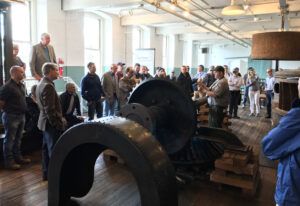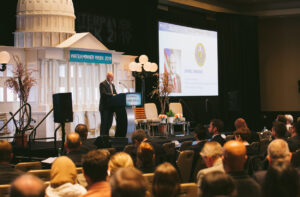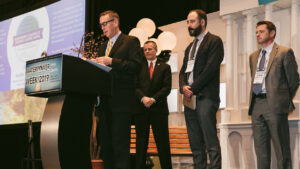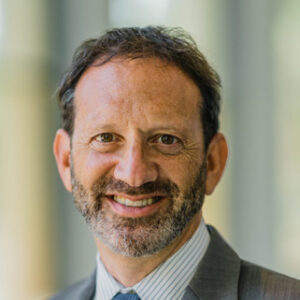The National Hydropower Association (NHA) is the national trade association for the hydropower association, encompassing all water power technologies, including traditional reservoir hydropower, pumped storage, wave energy, and tidal energy. While hydropower is often seen as a mature technology, it is still experiencing significant innovation and promises to be a crucial component of the 21st-century U.S. energy mix. In this interview, NHA President and CEO Malcolm Woolf tells Hydro Leader about the NHA’s activities and explains why national and state policymakers and regulators should update their views of hydropower.
Hydro Leader: Please tell us about your background and how you came to be in your current position.
Malcolm Woolf: I’m an energy lawyer by training and am a self-described policy wonk. I have spent most of my career advocating for sustainable energy technologies, including wind, solar, batteries, and electric vehicles. I’m a late adopter of hydro, but I’ve realized that it’s time to fall in love with hydro again. It’s America’s first renewable energy source and an amazing source of flexible, carbon-free power.
In fact, with over 100 gigawatts (GW) of zero-carbon electricity capacity already on the grid and the ability to act as a force multiplier to integrate variable wind and solar, hydropower is an essential part of any climate solution. For these reasons, I’m excited to join the hydropower family.

Hydro Leader: How long have you been in your current position as president and CEO of the NHA?
Malcolm Woolf: 15 months.
Hydro Leader: Would you please introduce the NHA?
Malcolm Woolf: The NHA is the national trade association for the hydropower industry, covering all forms of water power, including conventional hydropower, pumped storage, conduit hydropower, and marine energy. A lot of people think of the NHA as the voice of the industry in Washington, DC, which it certainly is. We actively engage with Congress and the administration, but we also convene almost a dozen events per year in which the industry can get together and exchange technical expertise. We also run a host of technical committees on subjects like hydraulic power, pumped storage, water power innovation, small hydro, and marine energy. The aim of those committees is to help the industry work through those issues and to train the industry. We operate as a chamber of commerce for the hydropower industry.
Hydro Leader: Who are your members?
Malcolm Woolf: Our more than 240 members span the entire supply chain, from soup to nuts, and include large generators, independent power producers, equipment manufacturers, engineering consultants, and legal support.
Hydro Leader: What sorts of technologies fall under the category of marine energy?
Malcolm Woolf: Marine energy covers a wide array of incredibly exciting technologies based on tidal, wave, thermal, and current power. We believe that marine energy is America’s next-generation renewable, and we are working to help this sector reach full-scale commercialization.
One of the most significant challenges to the domestic marine-energy industry is the need to continually attract private investment to fund innovation and initial demonstrations during the precompetitive stages of technology development, primarily due to the timelines and technical risk involved. Unfortunately, the United States has fallen behind its leading global competitors, which benefit from significantly higher government support dedicated toward research, innovation, and early commercial activities. The NHA is working to ensure that funding is available to accelerate research.

One of our members just installed a next-generation current energy project in New York City’s East River to take advantage of the river’s steady currents. There are also projects moving forward in Alaska right now that can provide power in remote areas where there is no grid. There is the potential for widespread use of the technology in decades ahead.
Hydro Leader: What are the NHA’s current top issues?
Malcolm Woolf: Hydropower is an amazing solution for the needs of the 21st-century U.S. grid. We currently provide electricity to roughly 30 million Americans, offering zero-carbon electricity with the flexibility to integrate variable wind and solar onto the grid. Hydropower also offers a wide array of other grid services, such as black start capability, spinning reserves, and voltage support.
However, the current system makes it unnecessarily difficult to realize hydropower’s potential. The licensing and relicensing process is too uncertain and expensive and takes too long. Hydropower is not treated equitably by the federal tax code, state clean-energy standards, or renewable portfolio standards. A big part of our advocacy deals with ensuring that people understand the flexibility that we provide and raising awareness of why hydropower should enjoy a level playing field with wind, solar, and other zero-carbon technologies.
Hydro Leader: In what ways is hydropower not treated equitably today?
Malcolm Woolf: Under the federal production tax credit, hydro only gets half the credits that wind and solar do. Similarly, existing hydro doesn’t count for most state renewable portfolio standards. Wind and solar get credits for every megawatt of carbon-free energy they generate, but most hydropower does not. It is hard to compete and attract inventors when you’re not getting the same tax incentives or state policy support, but you’re called on whenever the grid needs flexibility. Grid operators assume the hydropower industry will be there, but they are not compensating it for those services. Hydropower is more than just clean energy. The dynamic contributions it provides to grid reliability, economic efficiency, and resilience make it worth more than the sum of its parts. And with low natural gas prices leading to reduction in energy prices over the last decade, the economic and financial landscape has changed for hydropower operators.
With roughly 30 percent of hydro projects up for license renewal in the next decade, we must do everything we can to prevent them from becoming stranded assets. Doing so means creating new market mechanisms that can compensate hydropower flexibility appropriately, thereby establishing new, alternative revenue streams for the industry.
Hydro Leader: Who is the main audience for your advocacy activities?
Malcolm Woolf: If we want to get the policy framework to recognize the value that hydropower can provide, we need to communicate in multiple arenas. Congress is one arena— unequitable tax treatment is one example of an issue that falls under Congress’s authority.
The regional transmission organizations and independent system operators regulated by the Federal Energy Regulatory Commission are another. Market rules for wholesale markets is another topic on which we are increasingly active. Current market rules fail to recognize and compensate hydropower for the services that grid operators ask us to provide.
A third audience consists of the federal and state resource agencies that have a role in licensing hydropower facilities, including the Bureau of Reclamation, the U.S. Fish and Wildlife Service, and state clean water programs.
Hydro Leader: Do you also do communications work that is directed to the general public?
Malcolm Woolf: Absolutely! Through social media, digital advertising, and other tools, we work to raise public awareness of the benefits of hydropower. We’ve got a great story to tell, and I think many people take hydropower for granted and haven’t given it much thought in recent decades.
Hydro Leader: What are the main misconceptions that you are trying to overcome in your advocacy and communications work?

Malcolm Woolf: First, people should know that hydropower isn’t tapped out. Over the last decade, hydropower has added generation capacity, and significant growth potential remains. One way to add new generation is by powering existing nonpowered dams. Only 3 percent of U.S. dams and impoundments actually produce electricity. The vast majority of dams are designed for other purposes, such as flood control, irrigation, water storage, or recreation. Of the 90,000 dams listed on the official U.S. inventory, only about 2,400 have generation units. By adding hydropower to that existing infrastructure, we could generate a whole lot more power without building new dams or impoundments.
Another misconception we hear is the idea that if we just build more wind and solar installations and maybe some batteries, the grid will somehow balance out and work. From an engineering perspective, that’s not true, or at least it will not be within my lifetime. For the foreseeable future, we need gigawatts of long-duration energy storage and flexibility to balance the variable renewable energy sources. The only long-duration storage technology that’s cost effective right now is pumped storage. I don’t think the hydropower industry gets the credit for that that we deserve.
Hydro Leader: What are the major technological trends that are shaping the hydropower industry today?
Malcolm Woolf: Many people think of hydropower as a mature technology that is not being influenced by a lot of technological innovation today. They are absolutely mistaken. From bringing artificial intelligence and machine learning to the powerhouse to environmental enhancements, our industry continues to make technological advancements. Manufacturers have developed a new generation of turbine that helps address dissolved-oxygen concerns. Other companies have invented fish-friendly turbines that allow fish to continue migrating. There are innovations in fish passage, like Whooshh Innovations’ fish cannon. There is also a lot of exciting innovation to standardize design for nonpower dams and small hydro and marine energy applications, which are working toward full-scale commercialization.
Hydro Leader: What role can hydropower play in the recovery from the economic recession caused by the COVID‑19 pandemic?
Malcolm Woolf: Hydropower played a key role in keeping the lights on during this pandemic. Many hydropower companies invoked emergency sequestration procedures to keep their workforces healthy and on the job and to prevent electricity supply disruptions. At the same time, during the California summer heat wave, hydropower stepped up to provide roughly one-third of all electricity during the critical afternoon/evening ramp.
Hydropower also needs parity in federal tax treatment, which is why the NHA is supporting a new tax credit to accelerate dam safety and environmental upgrades and to encourage the financing of long-duration energy storage. Finally, hydropower should be considered on the same playing field with wind, solar, and other zero-carbon technologies in any climate package or clean energy standard.
Hydro Leader: What events is the NHA holding in 2021, and how is it holding them amid the pandemic?
Malcolm Woolf: This is going to be an exciting year for the hydropower industry, with three major events. First, we’re holding our Waterpower Week in Washington event virtually in April. Refocusing the event on the critical policy challenges facing the industry, we are going to take advantage of being virtual to expand our outreach on Capitol Hill and to connect people to the policymakers of the new administration.
Our second major event is the International Conference on Ocean Energy, also in April 2021. This will be the first time that the United States has ever hosted this international event. While we are forced to host the event on a digital platform, we believe that it will be a great opportunity to showcase state-of-the art marine energy technologies. We are hoping that the event will be able to reach an even broader audience of innovators than the traditional, in-person version because of the elimination of the need for international travel.
Finally, the NHA is launching, for the first time, our own trade show and conference, Clean Currents 2021. That will be an in-person event in Atlanta in October. Promoted by North American waterpower for the benefit of the industry, Clean Currents will showcase innovative solutions, thought leadership, and exclusive educational opportunities to ensure that the advantages of hydropower remain relevant long into the future.
We are so excited about all three of those big events. In addition, the NHA will be hosting five regional events across the country in 2021. The first few may be virtual, but we’re hoping that we’ll be able to come together again in person during the second half of the year.
Hydro Leader: In addition to your office in Washington, do you have a presence elsewhere in the country?
Malcolm Woolf: We’ve got staff working remotely in several places across the country, but our only physical office is in Washington.
Hydro Leader: Is there anything else you would like to add?
Malcolm Woolf: As a relatively new member of the hydropower family, I’m incredibly impressed by the dedication and innovation of the industry. For a technology that many people think of as mature and perhaps not as shiny as some of the other clean energy technologies, I am amazed at how much value hydropower provides. As we think about how to achieve the deep decarbonization of the electricity grid, investors are hungry for a zero-carbon technology that is dispatchable, clean, affordable, and reliable. It’s amazing that hydropower checks all those boxes and yet keeps getting overlooked in favor of sexier new technologies. I think there is huge potential for the industry to remind investors and regulators that there is already a proven, established solution in their own backyards, and no new dams or impoundments are needed to take advantage of it. Hydropower is an amazing solution to the needs of the 21st‑century grid.
Hydro Leader: What is your vision for the future of the NHA?
Malcolm Woolf: The NHA is the voice of the hydropower industry, which is entering an exciting phase. Our association is uniquely positioned to bring the industry together, and I’m excited about the launch of Clean Currents 2021, the first national industry trade show that is being put together by the industry for the industry. We’re also well positioned with a policy message for legislators on Capitol Hill and for regulators at the state and federal levels that hydropower is an essential part of any kind of climate solution. It needs to be part of legislators’ and regulators’ 21st‑century electricity planning. We have an exciting year ahead of us during which we will continue to bring the industry together, provide technical insights to our members, and make our policy voice heard.
Hydropower can play an even larger role in helping the nation climb out of the recession. There’s a whole backlog of work that is supposed to happen over the next few years but that has been disrupted by the pandemic. If we made a concerted effort to accelerate the development of clean energy infrastructure, we could build out more carbon-free, flexible energy resources and put people to work at the same time.
To give one specific example, there are three pumped-storage facilities that are fully permitted in this country. For the first time in 20 years, we’re ready to start construction on any one of those three facilities if we can simply resolve the financial challenges. I am hopeful that we can break ground on those facilities in 2021, although the pandemic has not made it any easier.
Hydro Leader: What are your expectations for the hydropower and energy policies of the new administration?
Malcolm Woolf: President Biden has announced that addressing climate is one of the four pillars of his administration. I read recently that of the 20 world leaders with whom he spoke upon winning the presidency, he raised climate with 18 of them. He recognizes that climate is a global challenge and that the United States has to be a leader in addressing it.
That bodes well for hydropower, because hydropower is a flexible, zero-carbon technology. Together, hydropower and pumped storage already provide over 100 GW of carbon-free electricity capacity. Upgrading the existing fleet, adding power to existing nonpowered dams, and building closed-loop pumped storage can add almost 50 GW of additional carbon-free generation, according to the U.S. Department of Energy. At the same time, hydropower is a force multiplier because of its ability to integrate variable wind and solar onto the grid.
The Biden administration has the opportunity to embrace hydropower as a critical part of a clean energy grid. To do so, however, requires the modernization of the antiquated and needlessly expensive licensing and relicensing process.
Malcolm Woolf is the president and CEO of the National Hydropower Association. He can be contacted at mwoolf@hydro.org.


